I gave up growing carrots for a few years. I was failing at them; I got discouraged and quit. I first got back in the game because I was wearing the title “Master Gardener” and felt ashamed to do so while being incapable of something so fundamental.
And then the way I started growing carrots again was by experimenting with whether they could be grown by transplanting. (Yes — contrary to common advice — they can, as I wrote about in this post.) But I was truly hooked after harvesting those first transplants, when I saw how much my family loved having carrots to dig up in the garden whenever they felt like “eating like a bunny,” as my son called it.
So, over the last handful of years I’ve been focused on improving my carrot-growing skills. Here I share what I’ve found to be the keys to success on the topics of most importance to growing carrots in Southern California.
Timing and temperature
You’ll see on a packet of carrot seeds something like this, “Sow in early spring or late summer.” But that’s not entirely accurate for Southern California.
For Southern California, a seed packet should say, “Sow from late summer through early spring.” I think of it as mid September through winter and into early April.
Technically, we can grow carrots all year round, even in summer like most other climates in the country, but I wouldn’t. Or, I should say, I wouldn’t expect great results. A few years ago, I made a point of growing carrots every month of the year and found that the ones that grew through summer just didn’t taste very good. The plants always looked good, but the roots tasted disappointing: bland or bitter or tougher in texture.
The kids still ate the summer carrots, but they’ll eat anything!
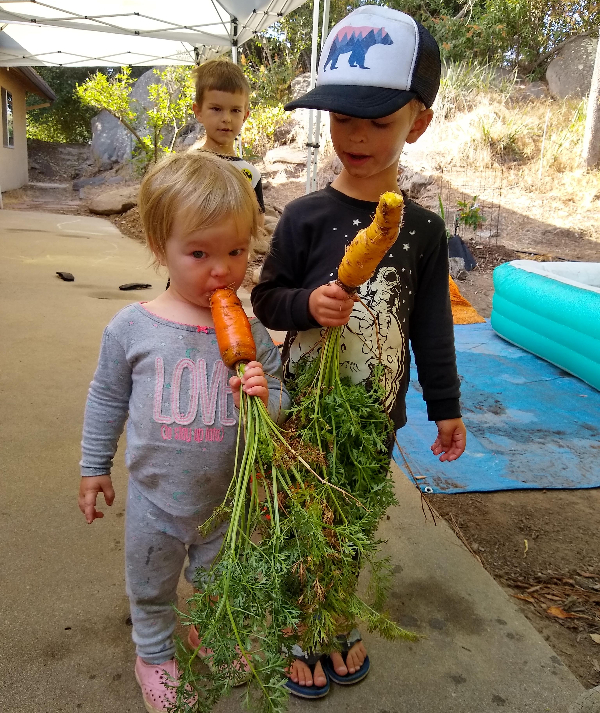
September is a great month to start growing carrots again, after the summer hiatus. Carrot seeds germinate fastest when the soil temperature is warm, between 65 and 85 degrees.
Fast-germinating carrot seeds: an oxymoron? It’s relative. According to this University of California chart, within that temperature range it takes carrots 6-7 days to emerge while in the colder soil temperatures of winter it might take around 20 days.
I sowed carrots on Monday, September 11, 2017 and then on Friday, September 15 I already noticed a couple of precocious germinators, like this little fellow:
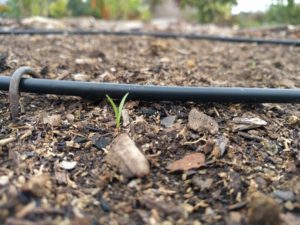
That’s only five days! Here are some other sowing and germination dates I’ve recorded in the past:
Sowed October 19, emerged October 28 (9 days)
Sowed December 15, emerged January 5 (21 days)
Sowed January 22, emerged February 13 (21 days)
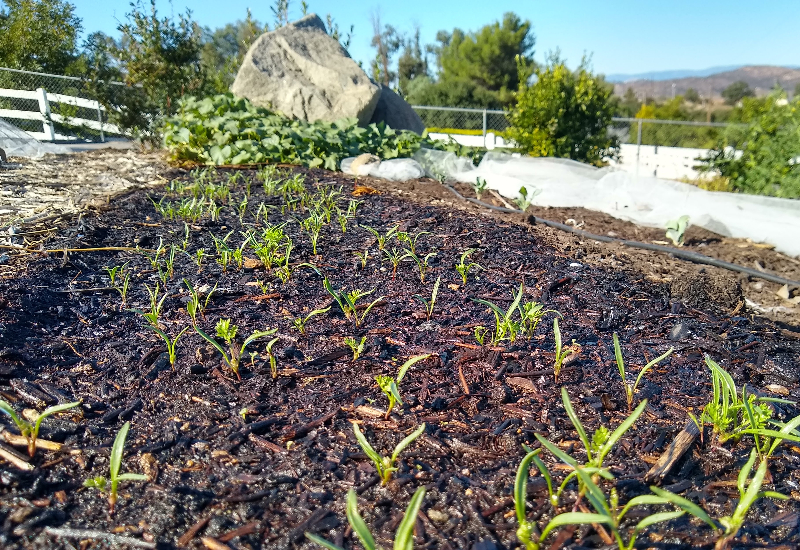
Soil moisture for germination
As you can see, the carrot seeds started growing faster in the early fall when the soil temperature was warmer, and this is so convenient because carrots are annoyingly slow at germinating in general compared to almost every other vegetable. Why is the slow germination annoying? Because carrot seeds are tiny and have to be sown shallowly (barely cover them with a quarter-inch of soil or compost) and yet they have to be kept moist for the entire time they’re sitting there in the soil getting started with life. If you let the carrot seeds dry out, they’re dead. So the faster they germinate, the less time you have to stay focused on keeping them moist.
A crucial first step to successful carrot germination is soaking the soil before sowing. Get that dirt wet to at least two feet deep.
After that, a few tricks to keeping that soil moist include laying burlap or newspaper or shade cloth over the dirt that you’ve sowed carrot seeds in.
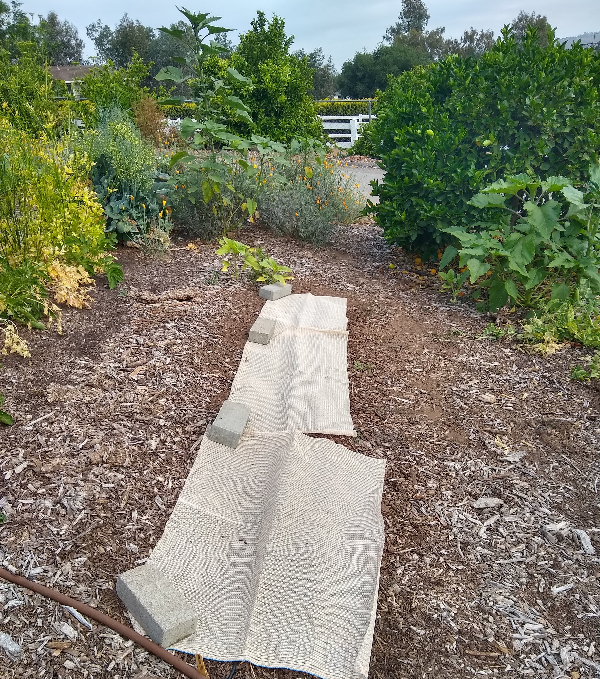
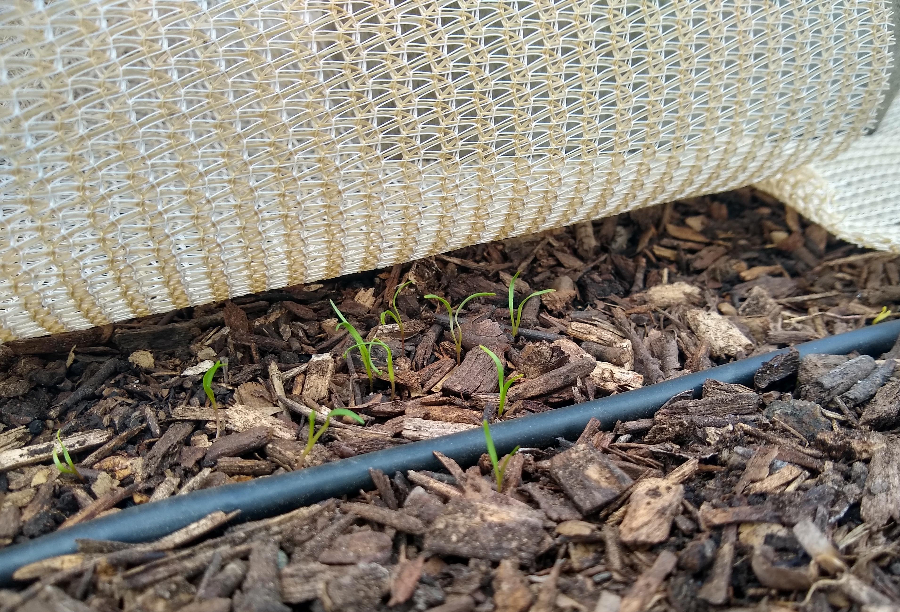
Alternatively, you can give the bed a showering every day. This will be sufficient even in September when afternoons are in the 80’s, but may not be quite enough during a period of heat or Santa Ana winds.
Soil texture and tilling
If you have a soil that forms a crust on top when it dries, that can be an obstacle for carrot germination. Adding compost to the surface helps prevent that crusting.
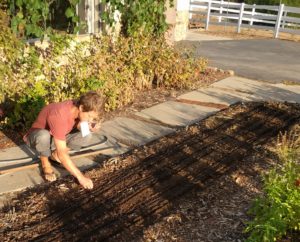
One last thing about dirt: it may not need to be dug up and loosened in order to produce good carrots. It depends on the dirt you’re working with. I have grown carrots in untilled dirt and found that they grew just as well and straight (or as poorly and forked) as in dirt I had tilled.
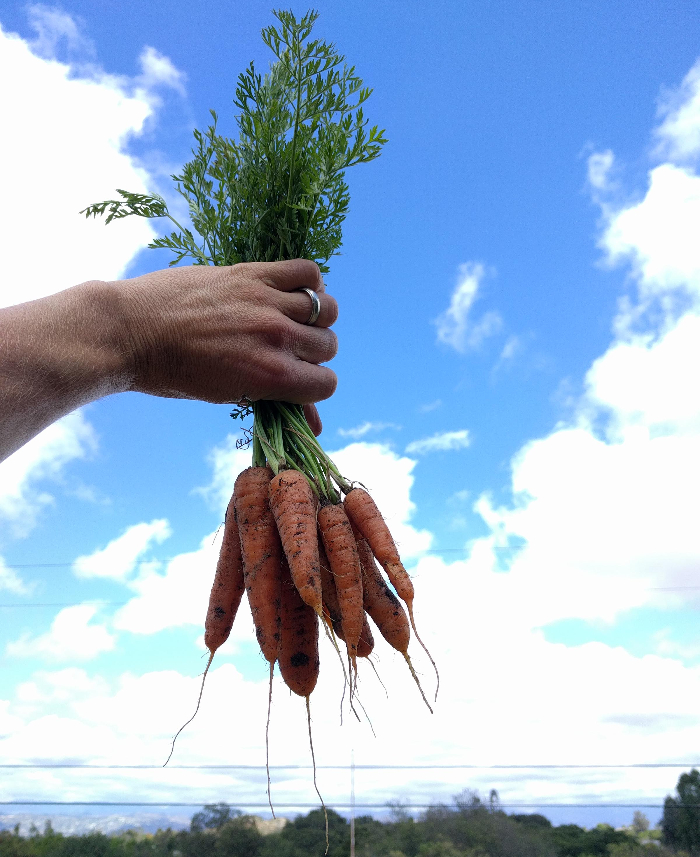
Despite that, I’ve found that the harvesting of the carrots is easier if I’ve forked the dirt before sowing. If I use a four-tine garden fork to loosen the dirt in the bed before sowing, then at harvest my family and I can pull out the carrots easily without breaking them. I appreciate that so I usually fork a bed before sowing carrots.
My soil is sandy loam. Your soil might benefit from some forking or tilling before sowing carrots, or it might not. In a raised bed, forking or tilling is likely a waste of time. Try it both ways and see how it goes.
Varieties
Carrots of various colors are fun for the kids. Purple, white, yellow, orange: which will it be? When they harvest it adds an element of surprise. But the one downside is that the non-orange carrots never match the fine texture and flavor of the best orange carrots.
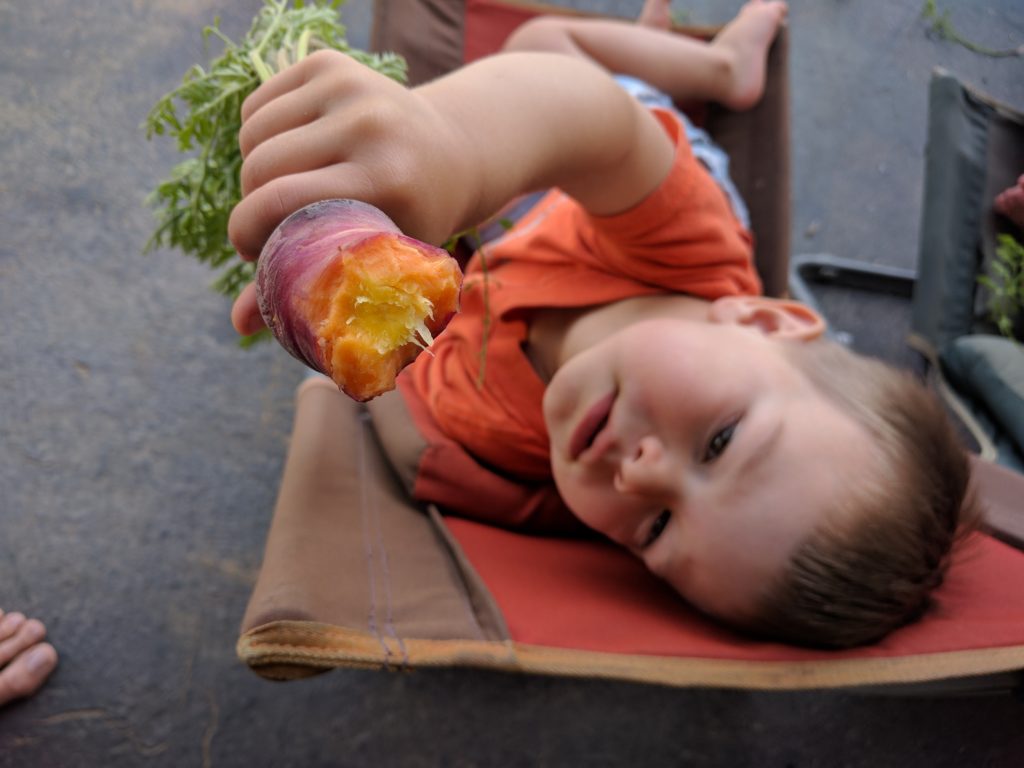
I still grow a packet of mixed-color carrots every year because they are so fun. I often grow Renee’s Harlequin Mix.
But for overall eating preferences, Mokum is the favorite variety for my family. It’s a variety that is perfectly crisp but delicate and coreless. The flavor is also just-right sweet. See my post on Mokum here.
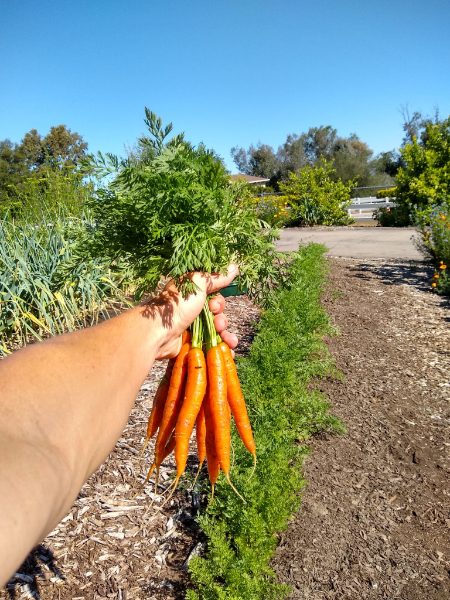
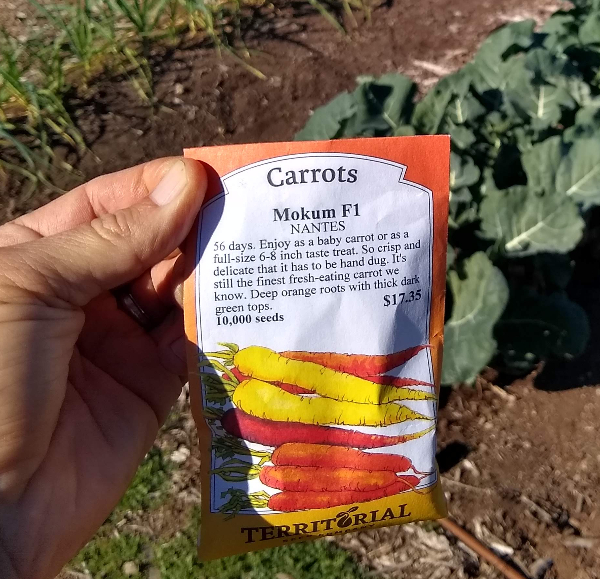
Bugs
Pill bugs and earwigs are two insects that love to eat carrot seedlings as soon as they emerge from the soil. Not controlling for these little pests was one of the biggest reasons for my carrot failings in the past.
I make sure a bed that I’m going to sow to carrots is bare for at least a week before sowing. This ensures that the pests aren’t hiding right there in the bed where I will sow.
I also sometimes run my chickens through the bed because they will eat all of those bugs.
Finally, for carrot sowings in winter, I sometimes cover the bed with tulle in order to prevent birds from eating the emerging seedlings, but I do not use shade cloth. Shade cloth gives pill bugs and earwigs a place to hide, and winter into spring is the time of year that their population is highest.
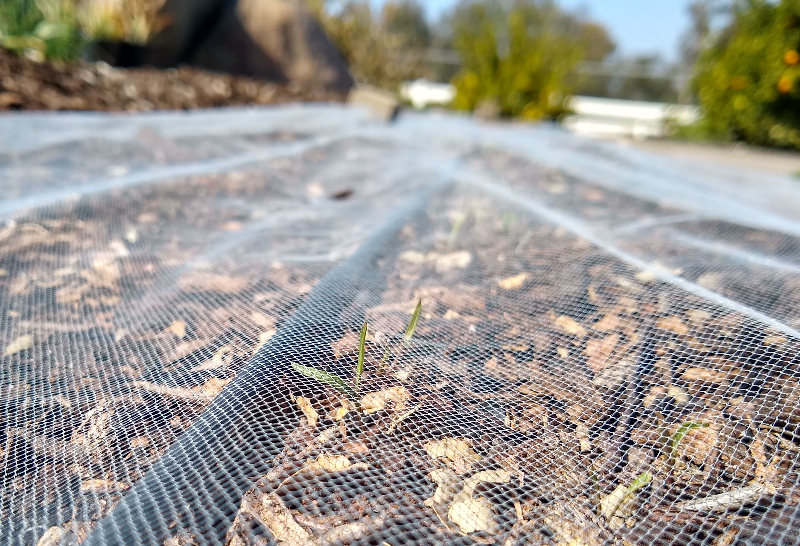
Alternative growing methods
You can attempt to cheat the system and go around the germination and bug challenges with carrots altogether by using transplants or growing carrots in a pot. Heck, might as well put carrot transplants in a pot. Some years back I grew a very nice crop of carrots in a pot that was only a little more than a foot deep.
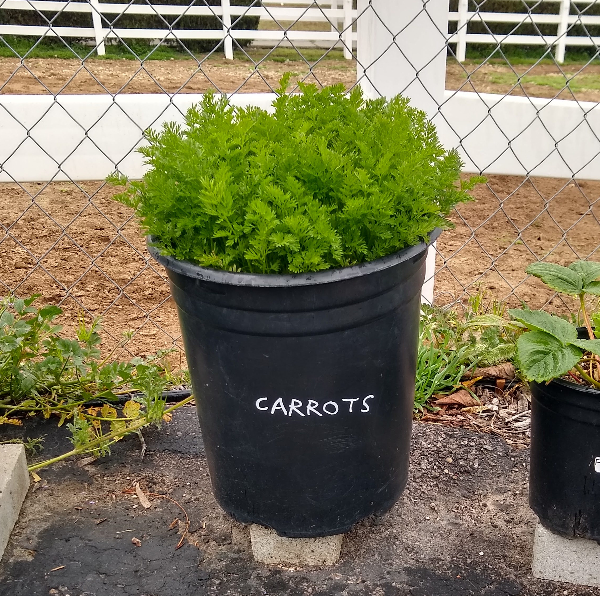
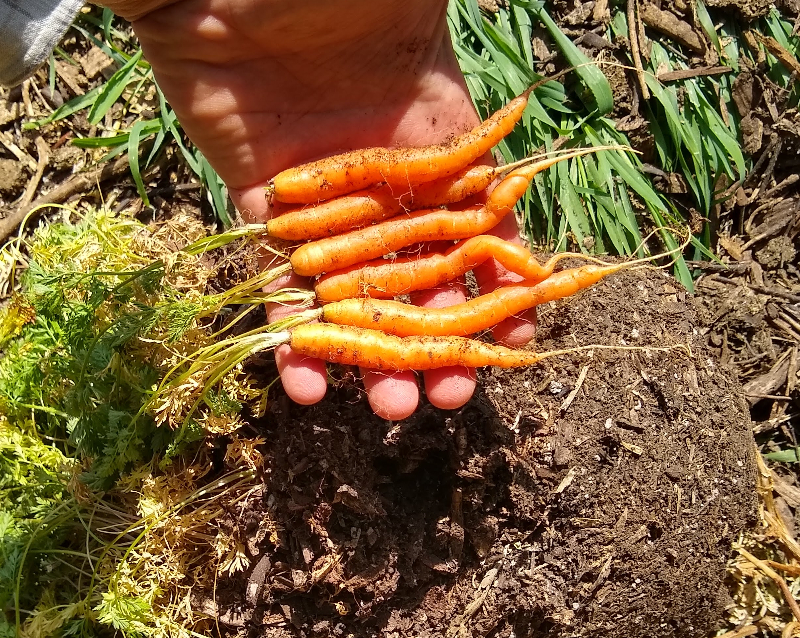
Harvesting
“Show me your carrot so I can take a picture of it.”
“Whatever, Dad. Just let me eat.”
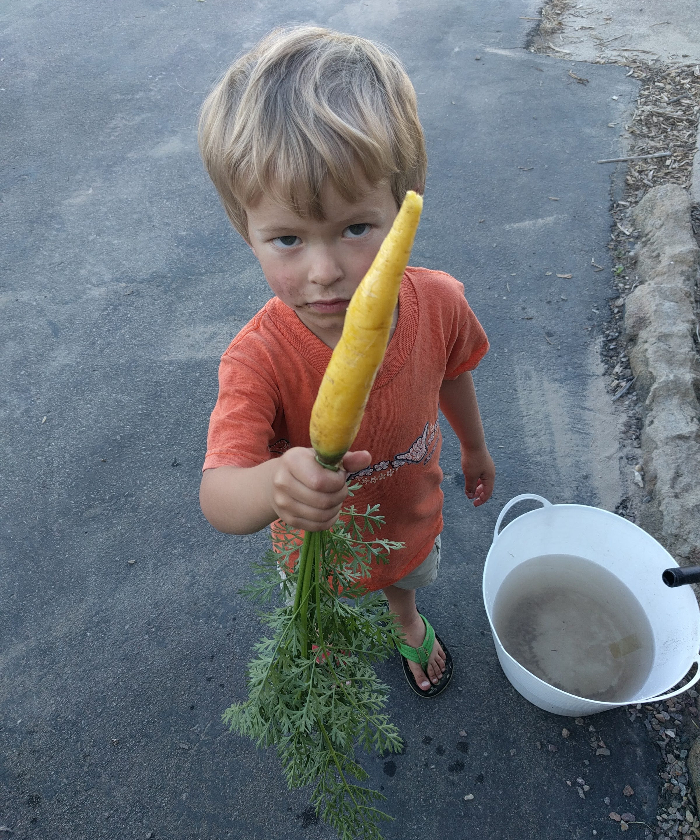
No ads on The Yard Posts because of your support. Thank you.
All of my Yard Posts are listed HERE

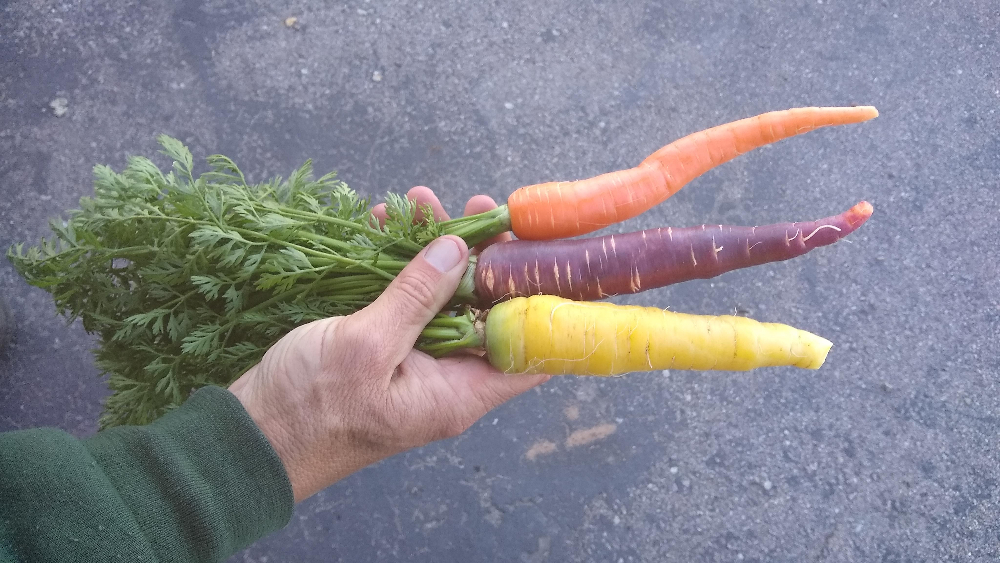


Hello,
I have just decided to plant carrots, and found your blog today! I was searching to find the best location in my garden. Full sun? Part shade? I have started my carrots on the window sill from the ends of my carrots i used for my chicken soup. They are sprouting just great and hoping to transplant soon. I do plan on putting them in a very large pot. Any additional advice would be great. Thanks!
Full sun is best for carrots in my experience although I have produced good carrots in partial shade too. I would never put my carrots in partial shade if I had the option of planting them in full sun.
My understanding is that by planting carrot tops you only grow more carrot foliage; you won’t end up with a new carrot root to eat. Is that your understanding or experience? I’ve never tried it, but it reminds me of planting onion tops, which grow onion foliage but not a new bulb.
Hi Greg. Thanks for the carrot tips. I am having a problem with my carrots splitting. The internet says the culprit is irregular watering. But my carrots are on a soaker hose timer! Are there other reasons they might be splitting? Thanks!
Hi Megan,
“The internet says . . .” I love that! By splitting, do you mean cracking or forking?
I’ve noticed that some of my carrots crack if I wait too long to harvest. But I can’t say if that’s always the cause.
I’ve noticed that my carrots fork if they run into something like a rock or piece of wood in the soil.
I’ll quote the California Master Gardener Handbook about carrots that have hairy roots, are forked, or are misshapen, in case this helps. It says the causes might be, “root knot nematodes; over watering; roots in contact with fertilizer pellets or fresh manure; hard soil or rocks; overcrowding.”
Do carrots need much watering? I’m trying to plan out where to put them.
Hi Jessica,
Not really. My routine is to deeply wet the area where I sow them before I sow them (wet to at least 1.5 feet deep), and then after sowing I might have to sprinkle to make sure the soil surface stays moist until germination. After germination I back off on watering for a while as the seedlings are sending their tap roots deep into that moist soil below but don’t have many leaves to use water. Then I resume watering, aiming to keep the dirt down deep moist so the roots develop as long as their particular variety allows.
Carrots grow well with tomatoes because both can root deeply and be watered infrequently (compared to some other vegetables, such as lettuce). That’s what I’ve noticed.
thank you!
Hi Greg,
Thanks for all the helpful posts. I’m planting carrots here, in mid-Nov. Your blog post says,
“A few tricks to keeping that soil moist include laying burlap or newspaper or shade cloth over the dirt that you’ve sowed carrot seeds in,…”
Can you explain how you use newspaper to shade carrot seeds? Do I just lay 1 or 2 sheets on top, then lift the paper up when I water the seeds?
Hi Toni,
I don’t know because I’ve never actually taken the newspaper route. I have used shade cloth though, and I lift it off to water and to check for earwigs, slugs, or pill bugs that might be hiding under there.
After reading your post, I was hoping to end my cycle of bad luck with raising carrots.
I planted a package each of organic Nantes and Parisian (spherical) carrot seeds in my raised bed veggie garden back in February (I’m north of you in LA County). I thought I was keeping them moist mouth, watering them 2x a day at 10 am and 3 pm. Here it is April, and only SIX of them germinated/sprouted. Dude, there were at least 50 seeds, maybe more, per package!
I have bird netting about the entire garden, so birds aren’t an issue. I use coir mulch which is very fine, so I haven’t had any snails, pill bugs or earwigs–not even in my strawberries, which is a first. I was using alfalfa mulch before and the coir is a vast improvement.
We did have a series of torrential downpours in SoCal back in February that may have dislodged the seeds and exposed them to the sun. I didn’t plant them very deep. The seeds were inexpensive enough so I felt it was worth a shot, but so dissatisfying to end up with like 6 carrots–assuming all goes well, that is. I’ve never seen carrot seedling starters here.
In any case, I’m going to leave the sprouted carrots there and gradually overplant with new summer veggie seedlings (tomatoes, etc.)
Hi Teri,
This is such a bummer! Carrots are so tricky! Here are some thoughts:
The seeds could have been old or poorly stored. Last October, I sowed two different packets of carrot seeds side by side in a bed. Each packet was a different variety and from a different company. One germinated well and the other was almost a total failure, with a handful of germinating seeds in a twenty-foot row. I can’t help but suspect the problem was the seeds.
The seeds were sown shallowly and the hard rain unearthed them, as you mentioned. That’s a possibility, for sure.
By the way, if the seeds were sown too deeply, you might find that they continue to germinate sporadically over the next few months — even if you plant summer veggies over them.
Hello,
I’ve been having some trouble growing carrots lately. I live in Murrieta, California and the temperature is currently in the 80s. Starting Monday the 23rd, the temperatures will be increasing into the 90s and by the 26th we’ll be in the triple digits. The rest of September will be in the 90s until the last week of the same month.
My question, should I wait until the temperatures drop below 90 to start growing my carrots? I have a packet of Nantes half long, Burpee seed tape.
Also, I get approximately 3+ hours of direct sunlight on my patio but I’m hoping a 4 ft long grow light will be enough to supplement any light needed for the germination process. Any suggestions would be greatly appreciated. Thank you
George Ramos
Hi George,
Your summer heat in Murrieta is similar to mine in Ramona, and I usually take the summer off from carrots and begin to sow them again sometime in September or October. Carrots don’t do as well in the warm soil of summer.
Thanks for your reply.
Hi Greg,
I came across your site not too long ago and loving my deep dive in here – thank you so much for this wonderful resource you provide!
I have never had much luck with growing carrots in the past but decided to give it a shot this year. To my surprise, they germinated in record time for me – about 7 or 8 days! Since I didn’t have much luck in the past, I basically just planted all the seeds in a raised box in rows..almost all of them germinated and are going strong.
My question is – what is the best way to thin them? I’ve seen some folks just cut them at soil level and (I’m sure you’ve heard this many a time) it kind of hurts my heart to do that. Is there a way to successfully dig them out when the soil is wet and transplant them? If so, how long should I wait to do this? Some have their second set of leaves while there are still some with just their first 2 leaves.
Thank you so much!
Thank you, Isabel. Just to say, I almost never thin my carrots. Don’t feel like you have to in order to get good production.
But if you want to, you can snip the stems at soil level with scissors. That’s the easiest way for me.
To transplant, I suggest using a pencil or popsicle stick or similar to “prick out” the plants. Sink the tool deep so the entire root comes up undamaged.
I would only do it with the youngest plants because the roots on the older ones will probably be too deep already.
Do it with the soil moist but not wet. The soil in the transplant area should also be moist but not wet.
And do it in the evening. Transplant immediately, and the little guys will have all night to settle in and be as unshocked as possible by the time the sun rises the next morning.
Water them in well right after transplanting that evening. Good luck! Let us know how it goes.
Greg, reguarding growing carrots in So Cal: How do you reccomend fertilizing—chemical and/or organic?
Hi David,
I simply keep a layer of compost on the surface of the soil of my vegetable beds. That’s the short of it. There’s some more detail here: https://gregalder.com/yardposts/fertilizing-vegetables-with-compost-pros-and-cons/
Hi Greg – I’m finally trying carrots again this year and have a bunch that have survived various bugs, weather, etc 🙂
I was wondering though – how do you decide/know when they are ready for harvest? Just pull a few out and try them? Do you go by date? Is there a negative to leaving them in the ground till we need them?
Thanks for any thoughts you have here!
-MB
Hi, May I ask approximately where in Southern Ca? A big area with lot’s of Zones !
The information is awesome! I live in Ventura county.
Thanks great posts !!!!
Hi Mark,
Thanks! I’m in Ramona, San Diego County, about twenty miles in from the ocean. I’ve seen that with carrots the only difference around Southern California is that if you’re within a few miles of the beach you can grow them through summer because your soil doesn’t heat up as much as it does inland. But carrots don’t grow quite as well nor taste quite as good in the middle of summer inland, plus they’re harder to germinate if you want to start them in the heat of summer inland.
Up your way, grow carrots all year in Oxnard, but in Ojai I’d take the summer off.
Hi:
I am so impressed with your life calling! Keep it up. We live in Pasadena and have 20 large box gardens plus blackberries, raspberries, boysens, grapes, and about 60 fruit trees (the ghetto neighborhoods had huge deep lots!).
Two vegetables I have trouble with are carrots and corn. For the former, what type do you recommend. I’ve planted some via seed and virtually nothing came up. Nantes seemed okay, though. I got tired of planting the ones from the nursery – they get all twisted together and are a pain to clean.
Corn: I have tried seeds and transplants and, at the end of the day, the ears are undersized and the kernels are gummy (does that make sense?). They get good sun exposure and plenty of water. What types do you like? Silver Queen was a bust.
Thanks; keep up the good work.
Hi Larry,
Thanks for the kind words. Carrots are a challenge for me too. I still sometimes have a total crop failure, and it’s almost always related to seed germination. If you intend to sow carrots in Pasadena soon (end of summer/early fall), the key is to shade the soil and keep it moist. I’d put a cover of shade cloth over the bed. (This is not necessary in winter though.) And before you sow (BEFORE!), deeply wet the soil.
My favorite carrot variety remains Mokum: https://gregalder.com/yardposts/the-mokum-carrot/
As for corn, if the kernels are gummy you might be harvesting too late. Try harvesting earlier. And sometimes an ear can go from perfect maturity to late in a single day! You have to be checking ears every day once they near maturity.
My favorite varieties are the less sweet kinds, but I know that others might like the super sweet ones. I also like the bicolor varieties. There’s something about the speckled appearance of white and yellow that enhances the whole eating experience for me. Check my corn post here: https://gregalder.com/yardposts/growing-corn-in-southern-california/
Hi Greg.
Your post on growing carrots was very informative. We live in Thousand Oaks on the Western side of the 101 so we are very much under the ocean influence. I planted a row of Nantes Half Long in mid September and plants are about two inches tall now. Just finished planting a row of Imperator seeds and am now interested in the Mokum variety that you enjoy. It is a new name for me so I will seek them out.
With regard to pests: I had been inundated with earwigs and some type of crickets for a few years. I eliminated their breeding spots and encouraged the lizard population (blue bellies and alligators) and have not seen an earwig or a cricket in a couple of years now. I do not use any pesticides or insecticides. The lizards are the best way to control these pests in my opinion.
Happy gardening.
Pete
Thanks, Pete. I love having lizards around too. It is one of the only downsides of our cats: they eat some of the lizards. Wish the cats were more trainable because I want lots of lizards around.
Hi Greg, a friend gave me a couple of carrot plants when she saw my raised bed lettuce and herb beds. I’m new to this, so not expecting a whole lot.
Is it possible to plant them in March, in south Orange County, CA?
I’m in Dana Point CA and just set seeds in a raised bed. 4 weeks ago and just now see the sprouts. I placed seeds in composted soil. In rows 5 inches apart with seeds 1 inch apart ,1/4 inch deep . . Planning to thin as needed. I’m a first timer at gardening finding info on the internet. I’d love to know Greg Adler’s thoughts on the possibilities for success and any tips for best practices .
Hi Greg,
Thank you for all your tips and your recent avocado harvest. Yum! I enjoyed a Gwen this morning.
Regarding fall seed sowing, I’m starting my planning now – yup, I’m a planner. 😉 But I have a wrinkle this year, I am heading out of town for Labor Day for several weeks. I’ll leave my husband behind but for the safety and well being of my veggies, I try very hard to keep him out of my garden. Would it be a waste to start carrot seeds at the end of August (with a timed drip system) and hope for the best?
I live somewhat coastal so maybe it won’t be too hot?
I could potentially ask my husband to water a bit if necessary.
Thanks for your thoughts!
Hi Georgia,
I enjoyed a Gwen with dinner last night. So good!
I am also planning for fall right now.
I have tried what you are proposing for carrots many times in many ways. I haven’t gotten good results from relying on drip to germinate the carrot seeds. Late August and early September are often the warmest, sunniest times of the year in your location too.
I would try to sow the seeds two weeks before you leave, and water the bed thoroughly before sowing, then handwater as necessary after sowing in order to keep the seedbed moist. When you leave at two weeks, the seeds will be germinating and you can rely on a timed drip system from there. (And your husband will be free from any blame!)